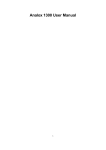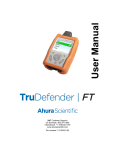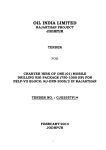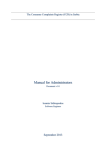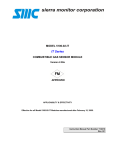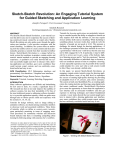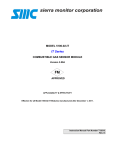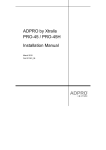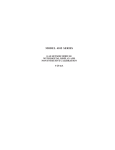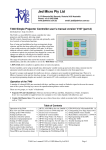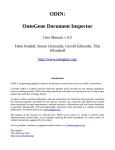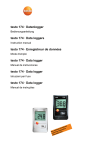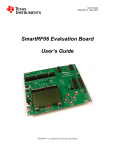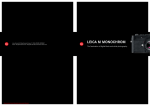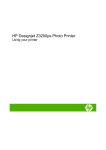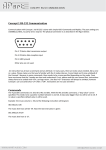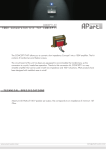Download new set for detection training with chemical reconnaissance devices
Transcript
THE SCIENCE FOR POPULATION PROTECTION 1/2010 ARTICLES NEW SET FOR DETECTION TRAINING WITH CHEMICAL RECONNAISSANCE DEVICES OF FIRE AND RESCUE SERVICE OF THE CZECH REPUBLIC Tomas CAPOUN, Jana KRYKORKOVA, Jiri ULBRICH, Daniel KALA [email protected] Delivered 23. 3. 2010, corrected 13. 4. 2010, accepted 21. 4. 2010. Available at http://www.population-protection.eu/attachments/027_vol2n1_capoun _krykorkova_ulbrich_kala_eng.pdf. Abstract Fire brigade units are currently equipped centrally with chemical reconnaissance devices, some of them belong to the world class detectors: detector Detehit, detection papers PP-3, chemical detector set CHP-71 with detection tubes, mobile detector for dangerous gases and chemical warfare agents GDA-2, and the mobile Raman-spectrometer FirstDefender. These devices are designed for chemical reconnaissance, namely for detection, identification, and determination of dangerous gases, vapors and chemical warfare agents in the air, and also for unknown liquid and solid substances identification, as well. Although these devices are quite simple to operate and to interpret measured data, their reliable use in a real situation requires necessarily regular operational training with specific agents. Therefore, a training set called IMKOP was developed at the Population Protection Institute. This set is designed for practical training with all above mentioned devices using all available techniques. Keywords Chemical reconnaissance, simple detection device, detection tube, detection paper, detector based on detector array, ion mobility spectrometer, mobile Ramanspectrometer, dangerous substance, chemical warfare agent, dangerous substance imitant. INTRODUCTION Number of incidents related to the release of toxic industrial chemicals, mainly because of technological and technical errors, industrial accidents and the arbitrary storage of chemicals in illegal places is increasing currently. Different forms of terrorism, particularly in connection with the use of chemical warfare agents (CWA) and toxic industrial chemicals (TIC), are still the most urgent and serious threads for the Czech Republic (CR) safety. Therefore, the new Chemical Service Concept1 of the Fire and Rescue Service of the Czech Republic (F&RS of the CR) built tasks for first responders, including detection and identification of 1 ARTICLES THE SCIENCE FOR POPULATION PROTECTION 1/2010 these toxic chemicals. Decisions on measures to protect first responders and population are based on results of detection and identification. In connection with the tasks resulting from Chemical Service Concept of F&RS of the CR, the research on methods and means of chemical reconnaissance and field analysis is realized at the Population Protection Institute. These methods and means serve to Czech fire-brigade units as the first measures for protection of population, acting integrated rescue system members, material and cultural values in the emergency situations connected with the release of TIC or CWA. Industrial and traffic accidents, TIC findings or their terrorist use, respectively, belong to these emergencies in fire-brigade units practice, before all. Security level of the chemical reconnaissance and laboratory control in F&RS has increased significantly by introducing some high-quality and effective equipment recently. These are relatively easy operable and results interpretable devices, but their handling requires necessarily regular practice. Most of the operators attended initial workshop at the Population Protection Institute. However, there were no opportunities for practical training with the devices, as well as for new personnel´s training, in the real situation. Should this training be relevant, it is necessary to perform it practically and with the real TIC. Training of liquid and solid TIC identification in conditions of fire-brigade units is possible. But training of atmosphere analysis, which is particularly significant, because of high risk of inhalation poisoning during emergency situations, is connected with many technical and security problems. The need for material and methodical support of the practical work with chemical reconnaissance devices of fire-brigade units resulted from the evaluation of the current status. Ministry of Interior – General Directorate of F&RS of the CR prepared a task for Population Protection Institute, on this basis, with the following aim: to develop a safe and simple testing kit for chemical reconnaissance devices training, namely for training with the detector Detehit, detection papers PP-3, chemical detector CHP-71, mobile analyzer of dangerous gases and vapours GDA2 and mobile Raman-spectrometer First Defender, and to create a methodology for their use. CURRENT STRUCTURE OF CHEMICAL RECONNAISSANCE DEVICES OF F&RS CR Fire-brigade units are currently equipped centrally with following chemical reconnaissance devices (note: there are a number of other devices, which are ensured by each regional centres individually): • the set of chemical detector CHP-71 with detection tubes, • simple detection devices Detehit and PP-3, • mobile detector of dangerous gases and chemical warfare agents GDA-2, • mobile Raman-spectrometer FirstDefender. 2 THE SCIENCE FOR POPULATION PROTECTION 1/2010 ARTICLES The Chemical detector CHP-71 (pic. 1) is a light mobile suction device designed for detection tubes air intake. The device is powered either by batteries or it can be connected to the onboard vehicle network. It enables air flow regulation, detection tubes heating in low temperatures, continuous operation in the vehicle, six-hours operation time outside the vehicle, sucking air through the soil samples and other solid materials, and lightning of the detection tubes chamber. Detection tubes (other synonyms are indication or testing tubes, tube detectors, etc.) are glass or plastic tubes containing a solid sorbent layer, which is either saturated by appropriate reagent, or the reagent is released from the ampule after air intake2,3. Contact of contaminated sample with the sorbent is secured by air sucking device. Czech market provides detection tubes for all types of CWA and some TIC. From all of these equipment, fire-brigade units use detection tubes for nerve-agents (marked as PT-44/2), sulphur mustard (PT-36/3) and combined tubes for phosgene, diphosgene, cyanogen chloride and hydrogen cyanide (PT145/2). Other types of detection tubes are ensured by fire-brigade units individually as needed. Beside chemical detector CHP-71, the Czech market offers currently also its new version - CHP-5, which enables more effective heating of detection tubes and may work with different types (lenght, diameter) of tubes. Pic. 1 Chemical detector CHP-71 3 ARTICLES THE SCIENCE FOR POPULATION PROTECTION 1/2010 The nerve-agents detector Detehit is an example of a simple device, which has a reagent saturated textile. It is basically a plastic strip with an indication paper sticked on one end. On the other end, there is a white detection and yellow colour standard textile layer next to each other (pic. 2). The Detehit detector works on biochemical reaction principle, which is based on acetylcholinesterase inhibition. It enables nerve-agents detection in water and water extracts, in air and on surfaces. Detection with the Detehit is very simple. It is based on dipping detection textile into the sample, dipping it in water and keeping it in the contaminated atmosphere for some time or wiping the surface, respectively. The plastic strip is bent then and indication zone is pressed to detection textile. If there is a nerve-agent or other acetylcholinesterase inhibitor (e.g. organophosphorus or carbamate pesticides) present, no colour change appears (detection layer remains white). In the other case, detection layer turns yellow. Colour standard layer is used for colour change comparison. The Detehit detector is very sensitive to nerveagents in the air. The sensitivity at 20oC and 2 minutes exposure is: for soman 0,008 mg/m3, for sarin 0,01 mg/m3 and for VX 0,05 mg/m3. Detection papers PP-3 (CALID-3) are designed for detection of liquid CWA and their division of nerve-agents (G, V) and mustard. They are available in a self adhesive booklet shape tearable sheets (pic. 2). The liquid droplets of CWA are soaked through the surface and they react with detection reagent, whereas G agents, V agents and mustard give different colour reaction. Pic. 2 Detection papers PP-3 and nerve-agents detector Detehit 4 THE SCIENCE FOR POPULATION PROTECTION 1/2010 ARTICLES The Mobile detector of dangerous gases and chemical warfare agents GDA 2 (pic. 3) is designed for CWA and TIC identification and determination in the atmosphere4-6. It is possible to work with the device in the field either in stationary or mobile mode. The GDA 2 can perform following tasks: • detection of unknown substance in the air • audiovisual warning at reaching default concentration tresholds of detected substances • identification and determination of CWA and TIC in the atmosphere • atmosphere monitoring • detection, identification, determination and monitoring of CWA and TIC on the contaminated surfaces. The GDA 2 detector works on the following four detection principles: • ion mobility spectrometry • photoionization detection • electrochemical cell detection • semi-conductor sensor detection. Each substance present in the atmosphere gives rice to a specific signal on one or more sensors if concentration is higher than the threshold one. Signal ratio from each of the sensors is evaluated by the device software. Data are compared with the library and then the device display the most probable single substance or, in the other case, composition of a simple mixture. Substance concentration in the atmosphere is counted from the signal intensity automatically. The GDA 2 detector is equipped with unique automatic diluting system, which protects the detection chamber from oversaturation by too high concentrations. This system controls dilluting of measured gas sample according the real measured signal. The cleaning process (Cleaning Mode) is another protection against overloading by dangerous gas chemicals, in which only ambient air, cleaned by filter, is aspirated into the device. Besides, the GDA 2 cleans itself in the Cleaning Mode before measurement. The GDA 2 detector is currently the only device for unknown gases and vapours analysis used by fire-brigade units, with the exception of Prague units and some mobile units of regional chemical laboratories of F&RS of the CR. The device is able to identify only the specific substances saved in library. These substances are supposed by European fire-brigade units to be the most probable to detect at the current level of chemical industry development and include: toxic inorganic gases – chlorine, ammonia, hydrogen cyanide, cyanogen chloride, sulphide, carbon disulphide, hydrogen chloride, hydrogen fluoride, phosphine, phosgene, hydrazine, sulphur dioxide, nitrogen dioxide and carbon monoxide; toxic aliphatic and aromatic hydrocarbons, chlorinated hydrocarbons – vinyl chloride, trichloroethan, trichloroethylene and tetrachloroethylene, also toluylenediisocyanate and oxygenous compounds – methanol, ethanol, formaldehyde, acrolein, acetone and acetic acid. The library contains furthermore chemical warfare agents, namely nerve agents (tabun, sarin, soman, cyclosarin, VX), and blister agents (sulphuric and nitrogen mustard and lewisite). 5 ARTICLES THE SCIENCE FOR POPULATION PROTECTION 1/2010 The analyzer enables measuring of gases and vapours contained in the atmosphere in following three modes: • The basic mode – GDA mode: is used for the first substance detection and identification in the air. This mode is automatically adjusted after switching the analyzer on and its display shows respective measuring channels and signals. Unknown chemical detection is running already in this phase, because if there is some positive signal on one or more channels, it means, that any substance is present in the air. Analyzer will identify the substance after signal stabilizing on the channels. In the case of positive identification, the display will show the name or symbol of identified substance and its concentration. • The photoionization detector measuring mode – PID mode: is used for accurate determination of toxic industrial chemicals in the atmosphere. It enables concentration measuring of the following 17 substances: acetone, acrolein, ammonia, benzene, chlorobenzene, carbon disulphide, acetic acid, ethanol, sulphide, hexane, hydrazine, isobutylene, styrene, toluene, toluylenediisocyanate, trichloroethylene, vinylchloride. Concentration determination in PID mode is possible only in the case of positive identification, and furthermore, the identified substance must be either the only one in the sample or strongly dominant over other toxic industrial gases and vapours, respectively. The display shows name (symbol) of the measured substance, the tolerable concentration value limit - ETW (i.e. the tolerable concentration limit for four-hour stay without respiratory protection) and the measured concentration. • The ion mobility spectrometer measuring mode – IMS mode: is used for eliminating false signals, if the GDA mode identifies a chemical warfare agent. The display shows three rows marked by G (for substances with positive detection in the positive mode, mainly nerve agents), by H (for substances with positive detection in negative mode, mainly blister agents), and by T (for other toxic chemicals), respectively. The display shows agent symbol and its concentration expressed in a bar graph. Pic. 3 Mobile detector of dangerous gases and chemical warfare agents GDA 2 6 THE SCIENCE FOR POPULATION PROTECTION 1/2010 ARTICLES The mobile Raman-spectrometer FirstDefender is designed for identification of solid and liquid samples, gels, sediments and pastes7,8. From the chemical point of view, the Raman-spectrometer can identify a wide range of organic and inorganic substances - toxic industrial chemicals, chemical warfare agents, explosives, drugs etc. Presence of referential Raman spectra in the spectrometer library is a prerequisite for the identification. On the other hand, the device is not able to identify bi-atomic molecules with ion or ion-polar bonds (e.g. sodium chloride), metals and most non-metal elements, water, polypeptides, highly fluorescent compounds, B-agents, gases, etc. Measuring of liquid samples is generally very quick and smooth. Big differences are met by measuring solid samples, which are caused, among others, by different positioning of the laser beam focal point. The difference between measuring liquid and solid samples is caused by the different device measurement technique. By measuring liquids – the focal point of laser beam is passing through the substance, while by measuring solids – the laser focal point is located on the surface. It means, that the darker and glossier the solid sample is, the more excitation light is reflected, and the more time the measurement takes. The spectrometer distinguishes isomers absolutely reliably. For example, it determines correctly the positions of chlorine atoms in chlorinated hydrocarbons. Thus, the device can differentiate 1,1,1-trichloroethan from 1,1,2- isomer or distinguish o-, m-, and p- dichlorobenzene. The ability to identify different components of a mixture is surprising, even though the manual considers the mixture analysis less reliable9. The identification possibility of all chemical warfare agents – present in the library – was succesfully verified at the Population Protection Institute. It can be highlighted at this point, that the significant increase of working safety, for the device ability to identify the substance directly in a closed ampoule and so prevent potential dangerous contamination, is a big advantage. Even highly decomposed CWA samples were identified and the spectrometer was able to distinguish products of the potential decomposition. Extensive testing was carried out by identification of explosives, when a special attention on working safety must be paid. The laser energy of hundreds mW can iniciate burning of the analyzed sample and a large explosion or a complete damage of the device in specific situations. The Raman-spectrometer also provided valuable results by field measurements of rocks and minerals10-12. Pic. 4 Mobile Raman-spectrometer FirstDefender 7 ARTICLES THE SCIENCE FOR POPULATION PROTECTION 1/2010 DEVELOPMENT OF THE TRAINING SET CONSTRUCTION From the intention to develop a training set and from current composition of chemical reconnaissance devices at F&RS, it is obvious, that, there are no problems with packaging of liquid and solid samples by PP-3 and Ramanspectrometer detection. The aim of practicing all available measurement techniques of the Raman-spectrometer, namely: • vial measurement, • direct measurement, • measuring through glass and plastic cover, determines the packing options. The set contains for this reason samples in vials, solid sample for direct measurement, solid sample in plastic bag, and liquid sample in plastic bottle, respectively. The crucial problem was in imitation of contaminated atmosphere. A number of options were proposed and tested, but all of them were limited because of working with GDA 2 detector. Measuring of vapours in bottle above the liquid, sorbent clay or cotton cloth soaked with the substance was thus tested. It is necessary to start interpreting of measured data after the stabilization of the substance name on the display is finished. In other words it is necessary to give the device time enough to the signal stabilization on the channels and to the software processing. Otherwise, the results are not reliable and the device shows false signals. Most of the false signals appear during signal stabilization shortly and temporarily, only. The necessity of signal stabilization on the channels results from the fact, that it is difficult for the detector to analyze rapidly changing concentrations. This is the reason, why it is absolutely erroneous to verify a function of the analyzer above the surface of a volatile liquid in a bottle, where the substance concentration can change from zero to saturated vapour concentration, depending on airflow direction. Such verification may lead at least to mistrust of the analyzer. The next theoretical possibility of vapour liquid measurement is transfering the sample into a gas sampling bag or other container by microsyringe. This technique would significantly reduce rapid concentration changes, but it has other disadvantages. The operator comes into the direct contact with the substance (often dangerous), the procedure requires training, and also very high price should be taken into account. After considering all aspects, we finally decided to inspire ourselves by training ampoules used for testing of the ion mobility spectrometers at the Bruker Saxonia Analytik GmbH Company (Germany). They contain a volatile substance sealed in a plastic ampoule in a screw closed bottle (pic. 5). Volatile substance diffuses through the plastic ampoule surface and creates a concentration suitable for practicing with chemical detecting devices. Other part of the studies concentrated on the timing of opening the bottle and proper distance of the analyzer. It was found out, that the most reliable results are obtained under these conditions: 8 THE SCIENCE FOR POPULATION PROTECTION 1/2010 • • ARTICLES imitation bottle is opened right before testing and right after measuring it is tightly closed; the bottle finish is closely approached to the detector suction (both GDA 2 and CHP-71) vertically to inlet axis (pic. 5). Pic. 5 Contaminated atmosphere imitant SELECTION OF IMITATING SUBSTANCES The requirement on high safety level of the kit was one of the most important conditions by selecting CWA and TIC imitants. A large number of substances were tested for the imitation purpose of various contaminants. Both – liquid form substances for PP-3 detection and also contaminated atmosphere imitants - were tested, as shown on the pic. 5, for the reason of Detehit detector, chemical detector CHP-71 and GDA 2 analyzer practicing. Substances were selected on the basis of own authors experiences, and of results from fire-brigade units training with the above mentioned devices. There were tested also CWA imitants used for training by the Organization for the Prohibition of Chemical Weapons (OPCW). On the basis of the substance and imitant screening for practicing with chemical reconnaissance means, comparison of the named devices responses to individual substances, and of the whole testing verification, there were proposed specific substances, which provide reliable positive results13, proven by practice. The other selection criterion was given by the intention to use one substance as an imitant for more devices, which consequently enables smaller size and lesser weight of the whole training set. 9 ARTICLES THE SCIENCE FOR POPULATION PROTECTION 1/2010 DESCRIPTION OF THE SET FOR TRAINING WITH CHEMICAL RECONNAISSANCE MEANS On the basis of the extensive testing with respect of the fire-brigade units needs, there was proposed and manufactured a set for the detection training with chemical reconnaissance means, which was named IMKOP (imintants of contaminated environment)13. The set has been designed for the detection training of gas, liquid and solid chemical warfare agents and toxic industrial chemicals using the following chemical reconnaissance devices: Detehit detector, chemical detector CHP-71, mobile detector of dangerous gases and chemical warfare agents GDA 2, detection papers PP-3 and mobile Raman-spectrometer FirstDefender. The IMKOP set consists of 18 samples in different packages (pic. 6) and enables 28 practical tests14. Pic. 6 Showcard of IMKOP training set Glass bottles No. 1 to 11 are designed for training purposes of detection and analysis of gases and vapours in the air. They contain a volatile substance each, which is flame sealed in the polyethylene ampoule closed in the screw glass bottle (pic. 5). The volatile substance diffuses through the polyethylene walls and creates concentration useful for chemical reconnaissance devices practicing. Glass or plastic bottles No. 12 to 18 are designed for the detection and analysis of liquid and solid substances training. Bottles No. 12, 13 and 14 are designed for training with detection papers PP-3, and have a dropper. The briefcase Makita 380 x 250 x 140 mm (w x d x h) was selected as the set package. It has a foam interior, which is perforated for individual components of the set. The whole view of the set is shown on the pic. 7. 10 THE SCIENCE FOR POPULATION PROTECTION 1/2010 ARTICLES Pic. 7 The whole view of the set for detection training with chemical reconnaissance devices IMKOP The training methodology14, which contains determination and description of the set, principles of working with contaminated atmosphere imitants, safety regulations, work operation and tests sequence, was developed for practical use. Two samples are designed for the detection training of nerve agents in the air by Detehit detector. One of them simulates the presence of nerve agent and the other one negative reaction. Another 4 samples are intended for chemical detector CHP-71, one of them for negative reaction, and the other three imitants for positive detection of nerve agent, mustard and phosgene, respectively. The other contaminated atmosphere imitants serve for GDA 2 analyzer training in different measuring modes. One of them simulates general presence of toxic industrial chemical in the air (without identification) and the other ones are intented for specific identification, all of them in GDA mode. The imitants simulate the following substances: acetone, cyanogen chloride, ethanol, styrene, acrylonitrile, methysalicylate and dipropyleneglycolmonomethylether. Imitants for VX, mustard, tabun, lewisite and chlorinated hydrocarbon serve for measuring in the ion mobility spectrometer mode. Hydrogencyanide imitant is intended for practicing of the whole reliable identification process of the nerve agent in the air, when identification in GDA mode is run first and then the operator switches the analyzer over to IMS mode and the result is verified. The three liquid imitants in droppers (No. 12 – 14) are designed for the positive detection of liquid chemical warfare agents by detection papers PP-3. 11 ARTICLES THE SCIENCE FOR POPULATION PROTECTION 1/2010 Positive tests of nerve agents G and V and mustard are the results of using these three samples. Samples for measuring with mobile Raman-spectrometer were selected with the intention to practice firstly, various measuring methods, and secondly, results interpretation possibilities. So, it is possible to indentify liquid and solid samples in both – glass and plastic covers or by direct measurement without any cover, and the results are individual substances or their mixtures. The set for detection training with chemical reconnaissance means IMKOP was manufactured in 30 functional samples and provided to all support fire-brigade units and chemical laboratories of regional F&RS. The price of one set self-manufactured at Population Protection Institute is 1,583 CZK (approx. 63.3 EUR). 82% of the whole price belongs to the briefcase. Résumé The set for detection training with chemical reconnaissance means (named IMKOP) was developed, validated and manufactured at the Population Protection Institute. The set was designed for detection training of gas, liquid and solid chemical warfare agents and toxic industrial chemicals using the following chemical reconnaissance devices: detector Detehit, chemical detector CHP-71, mobile detector for dangerous gases and chemical warfare agents GDA 2, detection papers PP-3 and mobile Raman-spectrometer FirstDefender. The set of standards consists of 18 samples in different packages and enables 28 practical tests. In practice, the set is supposed to improve the detection training quality of the support fire-brigade units, chemical laboratories of regional F&RS with their mobile units, and of the new personell´s training with chemical reconnaissance devices. Literature [1] Chemical Service Concept of the Fire and Rescue Service of the Czech Republic. Prague: Ministry of Interior – General Directorate of Fire and Rescue Service of the Czech Republic, 2005. 44 p. ISBN 80-86640-40-X. [2] LINHART, P. and CAPOUN, T. System of chemical reconnaissance and laboratory control in F&RS CR. Prague: MI – GD F&RS CR, 2005. 88 p. ISBN 80-86640-54-X. [3] PITSCHMANN, V. Analysis of toxic substances by detection tubes. 2nd edition, Drahelcice: ECONT CONSULTING, 2005. 194 p. ISBN 80-8666403-1. [4] CAPOUN, T. New gas analyzer in F&RS equipment. 112, 2009, vol. VIII, No. 4, p. 20. 12 THE SCIENCE FOR POPULATION PROTECTION 1/2010 ARTICLES [5] CAPOUN, T. and KRYKORKOVA, J. Testing of new gas detector GDA 2. Information bulletin of MI – GD F&RS CR – Population Protection Institute, 2008, vol. 19, No. 1, p. 5. [6] CAPOUN, T. Equipment of fire-brigade units by new gas analyzer GDA-2. Proceedings of the XVIII. International Seminar on the Separation Chemistry and Analysis of Toxic Substances. Lazne Bohdanec: MI – GD F&RS CR, Population Protection Institute, 2009, B.1. [7] CAPOUN, T. and MATEJKA, J. Raman spectrometer. 112, 2007, vol. VI, No. 2, p. 24. [8] CAPOUN, T. and KRYKORKOVA, J. Field substance identification by mobile Raman spectrometer. Proceedings of the XVII. International Seminar on Separation Chemistry and Analysis of Toxic Substances. Lazne Bohdanec: MI – GD F&RS CR, Population Protection Institute, 2007, B.1. [9] First Defender User Manual. Rev. D2. Wilmington: Ahura Corp. [10] JEHLICKA, J., VITEK, P., EDWARDS, H.G.M., HEAGRAVES, M. and CAPOUN, T. Application of portable Raman instruments for fast and nondestructive detection of minerals on outcrops. Spectrochimica Acta Part A, 2009, vol. 73, No. 3, p. 410-419. [11] JEHLICKA, J., VITEK, P., EDWARDS, H.G.M., HEAGRAVES, M. and CAPOUN, T. Fast detection of sulphate minerals (gypsum, anglesite, baryte) by a portable Raman spectrometer. Journal of Raman Spectroscopy, 2009, vol. 40, p. 1082-1086. [12] JEHLICKA, J., VITEK, P., EDWARDS, H.G.M., HEAGRAVES, M. and CAPOUN, T. Rapid outdoor non-destructive detection of organic minerals using a portable Raman spectrometer. Journal of Raman Spectroscopy, 2009, vol. 40, p. 1645-1651. [13] CAPOUN, T., KRYKORKOVA, J., ULBRICH, J. and KALA, D. Project of the set for detection training with chemical reconnaissance devices IMKOP. [Research report]. Lazne Bohdanec: MI – GD F&RS CR, Population Protection Institute, 2010. p. 32. [14] CAPOUN, T. and KRYKORKOVA, J. Set for detection training with chemical reconnaissance devices IMKOP. Training methodology. Lazne Bohdanec: MI – GD F&RS CR, Population Protection Institute, 2010, p. 6. 13













